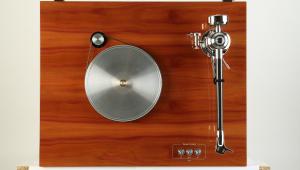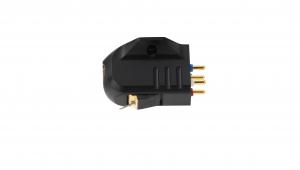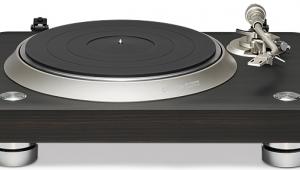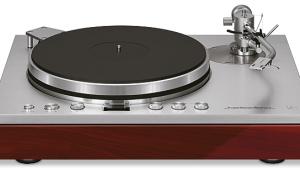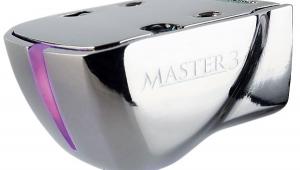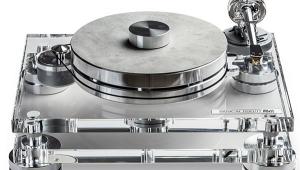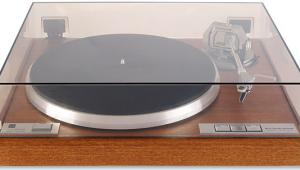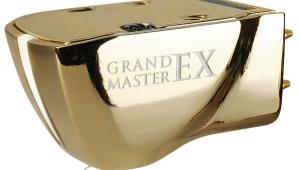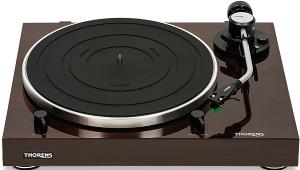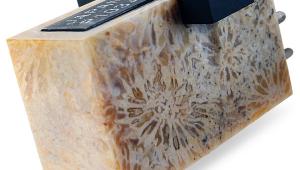Linn Majk Package (£1995)
There must have been at least a few moments in the 1990s when Linn came close to dropping the Sondek for good. In the brave new world of multi-room, AV and custom install products aimed at well-heeled Beocustomers, that old belt-driven LP spinner was becoming a serious anachronism.
Then there came a sea-change, as, to its credit, Linn seemed to rediscover its musical roots, launching the Majik CD playing system, and at around the same time starting to wheel out the LP12 for hi-fi shows once more. Subsequently, the latest enhancements of the LP12 and the Ekos arm have been highlighted as ‘SE’ upgrades. After this, you could say that the creation of a lower-cost vinyl source for the Majik range was entirely logical. Essentially, the Majik LP12 is an entry-level Sondek-based package with – and this is a real departure for Linn – someone else’s arm.
Visually, it’s perfect. Linn’s Adikt cartridge has a curvily pointed snout that completes the soft line of Pro-Ject’s integral cartridge platform and finger-lift, to create something reminiscent of Escher’s interlocking lizards. The pointed shape is functional too, because it makes accurate cueing easy. Meanwhile, the (replaceable) stylus is a Gyger II profile.
As for the turntable itself, there’s no electronic speed selection – instead, you need to fit the supplied pulley adaptor when you want to play 45rpm discs. You could always upgrade later to the two-speed Lingo power supply. Similarly, the standard subchassis and armboard could be changed for the machined-metal Keel. In other words, the Sondek/Majik package is fully upgradeable. If you want a lid, this comes as an extra at £140. As usual, the LP12 plinth comes in rosenut, black, walnut, American cherry or (as in our pictures) maple.
MUSICAL HAPPENING
With some twinges of nostalgia, I pulled out The King James Version [Sheffield LAB-3], and found that it came up as fresh as ever. From the first notes, there was that sense of a real musical happening. The bass was exemplary, clean, unexaggerated, tuneful and punchy, while the drum sound was extremely good, with cymbals ringing and singing with an arresting realism, even when the brass was blazing away. And the brass had a convincing rasp and bite which never went over the edge into grunge.
Sticking with old favourites, I turned to Daniel Barenboim, with the ECO in 1969, in Mozart’s Piano Concerto 21 [EMI ASD 2465]. Here, the sound had an immediately bright and quick quality, the instruments placed in a fairly believable acoustic, rather than swimming in an ambient mush. Woodwind and brass timbres were well characterised, underpinned satisfyingly by the double-basses and tympani, which started and stopped without smudging into a generalised boom. Strings were intense but not harsh or overbearing. The piano was clear and clean, with fairly good body to the sound, if not exactly sparkling. But as with almost every record I played, the Linn combination unfussily unleashed a sense of the rhythm within the music that subtly attracted and held your attention.
SOMETHING FLASH
Then I indulged in a series of audiophile delights from Pure Pleasure, starting with the astounding Annie Ross Sings A Song With Mulligan [PPAN ST 1253] from 1959. This was ‘A Strobophonic High Fidelity Recording’, whatever that could possibly mean, but the Linn faithfully exposed the artifice of the original echoey studio sound, perhaps intended to make Mulligan’s piano-less quartet sound bigger.
Next came the Stevie Ray Vaughan’s Texas Flood [PPAN 38734], with its bonus of the previously-unvinyled version of ‘Tin Pan Alley’ revealed in all its smooth and shining guitar glory. Once again, the Linn combination also excelled in producing an accurate, uncoloured bass sound that gave the music a true foundation. Finally, there was the always palatte-cleansing Joan Baez from 1959, which is a marvellous album, even though it had to be cut from the mono master [Vanguard VSD2077]. This cut raises the question, perhaps, of how big a mono ‘image’ should be, because it certainly has some width and depth.
And so, with another big twinge of nostalgia, I wound up with Rickie Lee Jones [Warner K56628], and found that the Linn had an easy and pleasant way with ‘Easy Money’, which hung together well rhythmically, again perhaps because the bottom end never became bloated. The track didn’t hustle along as it can seem to do with certain CD players, but it made sense. Even though Rickie Lee’s voice seemed just slightly veiled for some reason, the treble detail was excellent, revealing the key noise on the celeste, for example.
STILL ASPIRATIONAL?
Though it faces more competition than ever, the LP12 has remained a product to aspire too. Saving up for one, though, long ago become a disheartening business, because it seemed to cost more every time you looked at the price list.
Today, if you want a Linn with all the latest bits, moving-coil cartridge and a Linn arm, it will indeed cost you an arm if not a leg as well. But with the Majik LP12, you can enjoy the essential merits of the turntable for a lot less, in a package that works very well indeed. It can be heartily recommended.
Above all, the Majik LP12 proves that even after 35 years, the classic suspended-subchassis using traditional materials still has more to offer, in its unassuming way, than most turntables of the acrylic wedding-cake school. And it’s probably less likely to lead to divorce.
VERDICT
What you don’t get, arguably, is that final bit of ease, freedom and flair that a good moving-coil can bring. What you do get is a refined, well-balanced sound with great integrity, from the impressively uncoloured, well-timed bass through to a smooth mid and treble, that just keeps on offering an enjoyable way into every kind of music. An excellent package.
This review was originally published in the July 2008 issue






